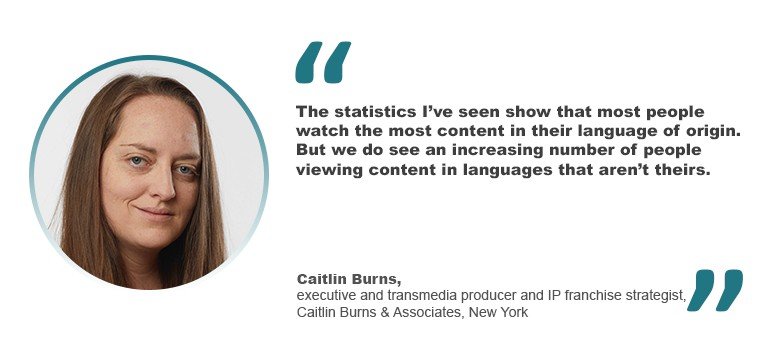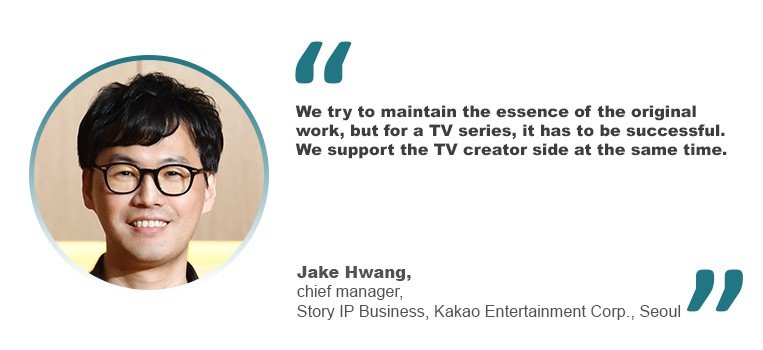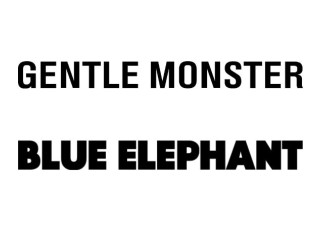How K-dramas are winning hearts worldwide
28 February 2025
From digital comics to global screens, webtoons are reshaping the entertainment industry. Cathy Li explores the IP strategies behind these adaptations, the challenges of balancing creative integrity with audience expectation and the growing impact of Korean content worldwide.
The glow of smartphone screens illuminates late-night reading sessions, one vibrant panel at a time, as readers around the world dive into the immersive universe of webtoons. Born in South Korea, these scrollable digital comics have evolved from a niche format to a global phenomenon, captivating audiences with their storytelling and stunning visuals.
Now, these webtoons are making a leap to bigger screens, with their characters coming to life, and gaining international attention on Western platforms like Netflix. From the neon-lit streets of fictional cities to the soft pastels of heartfelt romances, they are proving to be a goldmine for adaptations. Whether it’s the heart-fluttering live-action True Beauty or the adrenaline-pumping anime Solo Leveling with over 14.3 billion views, according to Korea Times, it leaves the audience coming back for more. The animation remains in the Top 10 of Netflix.
The rising popularity of webtoon adaptations reflects a broader trend: Korean content’s increasing global reach. “You already know that ‘APT.’ is a drinking game because culture is spread out through new media,” said Jake Hwang, chief manager of Story IP Business at Kakao Entertainment Corp in Seoul. He cited the viral success of “APT.”, a song by Bruno Mars and Rosé about a popular Korean drinking game, as an example of how cultural elements spread globally. Hwang made this statement in response to Asia IP’s question about the success of Korean content.
Hwang emphasized the importance of opportunity, noting that platforms like TikTok and YouTube have been steadily breaking down cultural barriers. The global exposure to Asian culture, he explained, has played a significant role in the success of Korean intellectual property.
What is Webtoon adapted K-drama and why is it so popular?
Comics, webtoons and novels have long been a wellspring of creativity, and the finest K-dramas adapted from webtoons are no exception. In South Korea, Webtoon is a publishing platform introduced by Naver, the country’s leading search engine. Their rising popularity inspired the idea of adapting them for television, and today, numerous highly acclaimed K-dramas on streaming platforms originated from webtoons – many of which have garnered praise even from viewers who typically have no interest in or familiarity with the genre.
Webtoons are capturing the attention of major studios and streaming platforms, with companies like Netflix investing heavily in securing adaptation rights from South Korean webtoon platforms. These platforms recognize the unique storytelling potential of webtoons, as well as their built-in fanbases, which provide a ready-made audience for adaptations.
What sets webtoons apart from traditional comics are two key features: their vertical scrolling format and episodic structure. The vertical scrolling design eliminates the need for readers to flip through pages or zoom in on panels, offering an immersive reading experience optimized for smartphones. Meanwhile, the episodic nature of webtoons – released in regular instalments – allows creators to use cliffhangers and plot twists to keep readers hooked. This serialized approach not only sustains engagement but also fosters a sense of community, as fans eagerly discuss and speculate about upcoming developments. It is also important to keep in mind that many webtoons are adapted from novels.
“Platforms like Webtoon and Wattpad are great for this, and it’s a natural fit, especially with the growing interest in Korean and Japanese comics in the United States,” said Caitlin Burns, executive and transmedia producer and IP franchise strategist at Caitlin Burns & Associates in New York. She worked on Batman: The Legacy Cowl, Pirates of the Caribbean and Descendants for Disney, to name a few.
She added that these platforms would translate into fantastic dramas like Trauma Code and that we will continue to see this trend of IP developed in comics and these more social, curatorial platforms finding their way into markets, not just regionally but as global success stories.

“The statistics I’ve seen show that most people watch the most content in their language of origin. But we do see an increasing number of people viewing content in languages that aren’t theirs,” Burns said.
Burns noted that while most people consume content in their first and second languages, there is a growing trend of viewers watching content in foreign languages. This is facilitated by excellent captioning and dubbing options provided by streaming platforms. She emphasized that great stories have universal appeal, transcending regional and local formats. The growing popularity of anime and the availability of K-dramas have led to an expanding audience, particularly among younger generations. This trend shows no signs of slowing down.
“The Three-Body Problem was created as an incredible Chinese drama and then reimagined for American and European audiences. Both shows are incredible, but there is a reality that the nuances of storytelling and the nuances of the story can be presented differently and still be valid. Both, I think, have done quite well, but you do see differences between those points,” said Burns. The fanbase has mixed reviews about the two versions. While the original Chinese show remained faithful to the novel, many voiced that there were too many episodes and very slow development. On the other hand, the Netflix-adapted version – which Netflix stylized as 3 Body Problem – trimmed the story a lot, making it more entertaining with better pacing.
This highlights a key challenge for IP owners: How to adapt a story for different audiences while staying true to its core. Burns explained: “As an IP owner, you’re trying to figure out how to tell the story that’s truest to the core human goal, everywhere you’re building your experience.”
The balance of staying faithful to the source material while recreating it for new audiences is at the heart of successful IP adaptions. Whether it’s a webtoon, a novel or a comic, the process of adaption requires a deep understanding of the original story’s soul and the creativity to bring it to life in fresh, compelling ways for global audiences.
Challenges of IP adaptions
Some of the most beloved K-dramas today trace their origins to web novels, with adaptations varying in their approach to the source material. While some stay faithful to the original story, others take creative liberties to expand or enhance the narrative. In certain cases, long-running series even go beyond the webtoon’s storyline, crafting new arcs to keep audiences engaged.
When popular webtoons are adapted into animation or live action, they often face the challenge of meeting the exceptionally high expectations of their dedicated fan base.

“We try to maintain the essence of the original work, but for a TV series, it has to be successful. We support the TV creator side at the same time,” Hwang explained. Adapting a web novel or webtoon IP into a TV series requires significant investment and time, and filmmakers face immense pressure to ensure the show’s success – otherwise, the effort may amount to nothing. As a result, when selecting an IP for adaptation, several factors are carefully considered.
Hwang elaborated on the considerations Kakao Entertainment takes into account when identifying IPs for adaptation. He noted that they analyze various metrics, such as readership, revenue generated by the webtoon or web novel, and sometimes demographic data. Additionally, they take into consideration the fact that women make up the majority of the audience demographics.
“The romance genre is very easy to adapt; however, fantasy, especially when the main setting is in historical times and the protagonist is reincarnated – those are hard to adapt,” Hwang said. He explained that production costs will be high, and for those that are difficult to adapt into live action, they will be the kind of content they focus on for animation.
This trend mirrors the long-standing dominance of comic book adaptations in Western entertainment. For decades, DC Comics and Marvel have reigned, with their iconic characters and sprawling universes dominating film, television and streaming platforms. DC’s Batman, Superman and Wonder Woman have become cultural icons, while Marvel’s Avengers, Spider-Man and X-Men have reshaped the blockbuster landscape. The Marvel Cinematic Universe (MCU) alone has grossed billions worldwide, proving the power of well-executed adaptations. Similarly, DC’s recent successes with shows like Peacemaker and The Batman demonstrate the enduring appeal of comic book storytelling.
For younger generations like Gen Z and Gen Alpha, being a fan is no longer just about consuming content – it’s about feeling a deeper connection to the stories they love.
As Burns explained: “It’s not just wanting to feel ownership over the stories that you love. It’s an expectation that being a fan who’s dedicated hours, days, years of your life to being part of these story worlds that you love should be reciprocated with some ability to have some participation in the creative process in the development of these worlds because they’re investing so much of their time already.” This sentiment reflects a growing desire for recognition and inclusion, where fans feel their passion and dedication are valued.
“For DC, they wanted to figure out how to connect with fans more deeply, how to explore new co-creative processes that reflect the engagement and investment of fans’ time and affection into these worlds that they love.” One such initiative was a program that combined elements of alternate reality games, fan clubs and exclusive access to the creative process. This program allowed fans to have a voice in the development of a new series of Batman.
“Back in the ‘90s, DC had allowed fans to call in to vote on the outcome of A Death in the Family comic book series, where it was you who was gonna determine whether Robin lived or died at the end of a story arc. This was groundbreaking. It was a toll-free number you had to use an actual telephone to be able to call in and count your vote, and that took an entire summer to be able to create a single opportunity for fans to have a choice.” While this was a significant milestone, modern initiatives aim to go even further. Burns explained: “What we worked on in this project was not just how can we give fans a voice in the creation of a new storyline, but how can we bring them deeper into that process.
“Cultural sensitivities and a detail-oriented awareness that not only do idioms and words have different meanings, but symbols may have wildly different meanings between different countries and even different cultures within countries,” Burns said. She emphasized the importance of recognizing these cultural nuances. Consulting with someone knowledgeable about cultural geography and differences is essential to avoid unintentionally offending or misinterpreting symbols, which can be highly specific and problematic for certain audience groups.
The future of storytelling
Looking ahead, the integration of virtual reality (VR) and augmented reality (AR) into IP storytelling is set to revolutionize the way stories are told and experienced. While audiences currently watch and listen to stories through movie screens – sometimes enhanced by immersive elements like moving chairs in theatres – or engage with characters in video games, the fusion of these technologies heralds a new era of storytelling. This shift allows viewers to feel, hear, see, and actively participate in the narrative, transforming the storytelling landscape into a more interactive and engaging experience.
Today, new forms of storytelling are already pushing boundaries. Interactive films and series, such as Netflix’s Black Mirror: Bandersnatch, allow viewers to make choices that influence the plot, creating a personalized narrative. Podcasts and audio dramas are also gaining traction, offering rich, immersive experiences through sound design and voice acting. Social media platforms like TikTok and Instagram have given rise to micro-storytelling, where creators share bite-sized narratives that resonate with global audiences. Additionally, transmedia storytelling – where a single story unfolds across multiple platforms, such as books, games and films – is becoming increasingly popular, offering audiences deeper engagement with their favourite worlds and characters.
Specifically, VR will enable users to immerse themselves in a compelling world and experience agency as a first-person character, offering a level of engagement that other platforms cannot provide. This has led some creators to chase new technologies with their IP, drawn by the novelty and freshness they offer. However, as Caitlin Burns pointed out, the excitement surrounding VR doesn’t always align with the practical realities of production.
“But the enthusiasm for VR and the wide audience interest, the wide courage of it didn’t match the actual technology that was required to make it a high level and the budgets to create it were more than three times what making it a traditional film piece,” Burns said.
She further explained that “just because a new technology feels exciting doesn’t mean it’s producible yet. And that’s one of the hardest things about working in emerging media and encountering these really wonderful ideas. Sometimes the technology just is not ready for you to produce the experience you want with it yet.”






